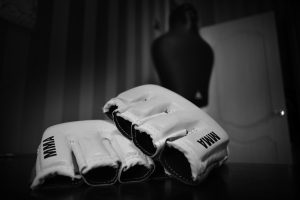Authors: Luke Hasskamp & Molly Donovan
In yet another important labor-monopsony case, a federal court in Nevada has declared a win for MMA athletes fighting against their promoter’s alleged misuse of monopsony power in the market for acquiring fighters’ services. Class certification has been granted to MMA fighters accusing their promoter of locking them into exclusive contracts that deterred fighters’ mobility and suppressed their wages for fighting bouts. Cung Le v. Zuffa, LLC, No. 2:15-cv-01045-RFB-BNW, 2023 WL 5085064, 2023 U.S. Dist. LEXIS 138702 (D. Nev. Aug. 9, 2023).
The Facts. MMA is a combat sport—a mix of boxing, wrestling, karate and other forms of martial arts. A bout is a competition between MMA fighters in a timed round where a fighter can win by acquiring the most points or by a knockout or submission (the other fighter gives up due to “extreme pain”).
During the at-issue period (2010-2017), Zuffa (defendant) promoted MMA bouts—under the trade name Ultimate Fighting Championship.
During that time, Zuffa treated fighters as independent contractors and compensated them on a bout-by-bout basis: one payment to “show” (participate in a bout) and then another payment (typically in the same amount) to win. This method of compensation was common across all MMA fighters promoted by Zuffa except for a “very small” number of the best fighters who also may have received additional payments at times (e.g., a percentage of the revenues generated by a particular event). Fighters bore their own expenses for training and skills maintenance.
The contracts between Zuffa and fighters contained “exclusion clauses” that required athletes to fight only for Zuffa. These contracts also imposed additional clauses that gave Zuffa significant control over fighters, including (i) the exclusive ability to extend certain contracts automatically; (ii) the exclusive right to cut fighters; and (iii) the right to match a competing promoter’s offer at the expiration of a contract, essentially requiring the fighter to remain with Zuffa whenever Zuffa matched the competing offer.
The Proposed Bout Class. All persons who competed in live UFC-promoted MMA bouts in the United States from 2010 to 2017.
Predominance. Predominance has become the “main event” in antitrust class certification inquiries—the round where a plaintiff can win it or lose it all. To establish predominance, plaintiffs must show (i) conduct that violates the antitrust laws; (ii) that the conduct was commonly applied to the class; (iii) it led to common injury in the class; and (iv) measurable damages provable with evidence common to the class.
- Illegal conduct. The class alleges a violation of Section 2 of the Sherman Act, i.e., that Zuffa sought to maintain its monopsony power in the relevant market through exclusionary conduct. In a lengthy analysis, the court held that plaintiffs showed that Zuffa enjoyed monopsony power in a relevant antitrust market—the market for elite professional MMA fighter services. An expert testified that, during the relevant time, Zuffa’s share was between 70 and 90% in the labor-input market. And this market also had significant barriers to entry, including Zuffa’s own “coercive” contracts that “artificially restricted” competitors’ access to fighter talent. As for exclusionary conduct, the court ruled that the required exclusivity and other oppressive contractual provisions (along with related “coercive” conduct by Zuffa) “locked up” fighters, restricting their mobility and suppressing their wages. The court also pointed to Zuffa’s history of horizontal acquisitions as further evidence of a willful intent to maintain market dominance.
- Common application to the class. The court found that the relevant contractual provisions applied to all class members, as did Zuffa’s coercive conduct used “consistently” “to induce fighters into re-signing contracts or risk punishment.”
- Common injury. Plaintiffs’ expert submitted a regression analysis to show that class members’ wages were artificially suppressed by Zuffa’s conduct. The court ruled that analysis was sufficiently reliable at the class certification stage to establish common injury—rejecting defendant’s “small” criticisms of specific variables and particular data decisions.
- Finally, the court held that plaintiff’s expert presented a “coherent methodology for establishing class-wide damages that predominates over any individual damages analysis.”
Total Knockout? No. While the court certified that “bout class,” it declined to certify a separate “identity class” consisting of every fighter whose identity was “expropriated or exploited by the UFC” from 2010 to 2017. The court held that, unlike the bout class, plaintiffs had not presented sufficient expert analysis supporting a connection between the relevant exploitative conduct and suppressed compensation. The court also found it important that the merchandising rights were voluntary and non-exclusive and that fighters in the class varied in notoriety—a difference difficult to capture in an objectively-defined variable. Finally, the court said there was no evidence of an “internal pay structure” for identity rights that was consistently applied across the proposed class.
 The Antitrust Attorney Blog
The Antitrust Attorney Blog












